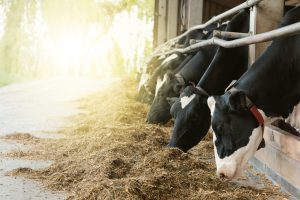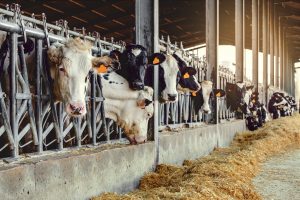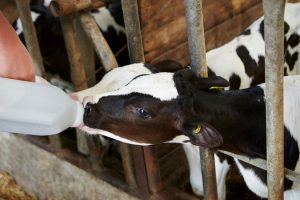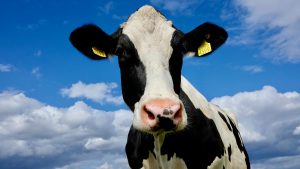Alvaro Garcia
The economic environment has suffered a rapid downturn as a result of the current world pandemic. Businesses from all walks of life are struggling when not closed and the dairy industry is no exception. The Chicago Mercantile Exchange has dropped almost 39% in value and there is still no bottom established. For the next couple of months, it is expected milk mailbox prices will be significantly below operating costs of production. Since this situation might last until the fall it is critical to understand what’s affecting the farm’s profitability.
In very simple terms, dairy farm profitability can be defined as the difference between milk prices and the cost of production, multiplied by the kg of milk produced. Thus, milk prices, the cost of production, and the kg of milk produced are the three critical components for dairy profitability. Therefore, it is very important for producers to have a firm grasp on the three components (price, cost, and volume) of this equation and attempt to modify them in their favor. When milk prices are high and input costs low, producers should use all possible means to improve production and increase gross returns. When the milk price/input ratio is not that favorable, the approach is usually to cut costs, but this short-term, savings approach oftentimes affects medium- to long-term cow productivity and the milk, overall, shipped from the farm. It is critical for producers to identify those areas where they can reduce costs without having an impact in the cows both in the short and/ or in the long term.
Critical areas to address on the farm
- Focus on diluting fixed costs
- Retain only profitable cows
- Clean up any management flaws
Reducing expenses
- Do it in areas that do not directly affect the cows
- Increasing the production from existing cows, is undoubtedly the best way to improve net returns
- Improve forage quality
- If you have not done it already contract feed at current low prices
- Consider using locally available coproducts to stretch forage inventories and perhaps decrease feeding costs
- Contract fuel at current low prices
Costs of production
Costs of production are influenced by the size of the operation and how effectively the operation uses its assets. Total costs of production can be divided into operating costs and allocated overhead costs. The operating costs are usually composed of feed, veterinary, bedding, marketing, custom services, energy (fuel, lube, and electricity), repairs, and interest on operating capital. Certain “expenses” are more of an investment in the cash-generating units, the dairy cows. Reducing feed costs by purchasing low quality feeds is a short-lived solution. Saving money by using less bedding or replacing it sparingly also negatively impacts production, cow longevity, and ultimately the milk check. The same goes for other expenses such as veterinary costs, hiring qualified labor, and general heifer and cow care. Expenses that do not have a direct positive impact on the cows or are not critical for normal farm function should be postponed. Purchasing new equipment, vehicles, or land, paving the driveway, or painting the barn can wait for a better economic environment. Purchases of dairy replacements need to be carefully assessed from an economic perspective. Why are additional replacements required? If it’s due to high culling rates, one should first improve management and facilities to increase the productive life of the current herd.
Operating costs represent roughly 60% of the total costs of production in Midwest dairies. The largest component, by far, is feed costs (almost 70% of the total operating costs representing 40 to 50% of total production costs (operating plus allocated). From a producer’s perspective, it’s always tempting to reduce feed costs in order to improve net returns. Reducing feed costs would make economic sense only if substituting an ingredient or removing an additive does not impact production or breeding in the short or long term. But it is difficult to think of a given feed ingredient in the TMR that was added out of impulse and is not needed to sustain current production. Almost anything can be removed from a ration in small amounts without seeing immediate negative effects. The problem are the deferred effects that might be evident after a few weeks, months, or even on the next lactation. The last thing we want is to compromise the current or future production, eroding the positive end of the profitability equation—i.e., the total milk shipped. After all, the money used to produce milk after other expenses are paid for (fixed costs), has the best return on investment. After all, one kilogram of feed can result in 1.5 liters of milk. Considering feed and milk prices around the world, it is still a better return on your money than with any bank.
If reducing feed quality may have deferred, negative effects on cash flow, trying to save money on other expenses that impact the cow directly can have an even more drastic consequence. Veterinary expenses, medicines, and hoof trimming usually represent around 8% of operating costs. There is very little that can be done here except for preventative medicine. This dovetails with feed quality since adequate amounts of all nutrients are not only essential for milk production but also are key to boost the cow’s immunity. Deficiencies in key nutrients (e.g., specific vitamins and minerals) will reduce disease resistance and leave the cows vulnerable to ailments that otherwise would be effectively fought off.
One area where there is usually temptation to reduce costs is bedding. But the short-term savings here can be quite costly in the medium-to-long term. Bedding usually represents only 2% of the operating costs. Does it make sense to try to save money in bedding? What are the consequences of reducing bedding? Recent research has shown that when stalls were bedded with sand 5 cm. under the curb, cows reduced the time they spent lying by 2 hours per day. Conversely, an increase in 2 hours per day of lying time was observed when roughly 8 kg of sawdust per stall were added on top of the mattresses. Another experiment showed that with wet bedding, cows spent spent lying 5 hours per day less and increased the time perching with just 2 feet in the stall. Reduced bedding and/or replacing it less often leads to cows standing longer. When cows remain standing, two things happen: 1) their posterior hooves spend more time wet, absorbing more water and reducing their hardness, and 2) These hooves bear more weight as the cows’ center of gravity shifts towards the rear for 2 or more additional hours per day. The unwanted outcomes are hoof lesions and lameness. Lame cows incur higher production losses and have lower fertility and greater culling rates. Deaths due to lameness or injury have increased lately and they continue to be the second highest culling reason in the U.S., right after mastitis.
Of all the parameters that affect profitability of a dairy operation however, milk and feed quality have the greatest impact. Improving milk quality enhances profitability through milk quality premiums, increased cow productivity, and reduced cost of production. Milk quality will also affect feed efficiency indirectly through increased productivity at similar feed intakes. Forage digestibility continues to be among the main parameters of highly profitable dairy production systems.
Opportunity milk
Profitability is a function of the milk price minus the cost of production, multiplied by the volume produced. Reducing the cost of milk production makes sense only at constant milk prices. However, when milk prices drop below already adjusted production costs, where else can you cut costs before it starts to show in reduced productivity?
Opportunity milk is the additional milk produced by a cow that has the genetic potential to respond when management conditions improve. This additional milk produced by existing dairy cows generates the most profit on a dairy farm. The cost associated with producing this additional milk is usually only the feed, turning income over feed costs into net profit. The opportunity milk dilutes fixed costs because these are already factored in. Always make sure each stall is occupied by cows milked to their genetic potential and outperforming any young herd mate waiting to replace them. If the barn is slightly overcrowded, make sure every stall is functional and that feed-bunk space is not limiting. A slightly overcrowded facility can improve total milk shipped only if it does not compromise cow comfort. Since farm profit is determined by the volume of milk shipped. Even with optimum input-output prices, profitability is only maximized when enough volume is produced. A dairy that has 100 stalls, 80 of which are occupied by milking cows producing 32 liters each, will ship less milk than a similar-sized dairy that produces 27 kgs per cow but has 100% stall occupancy. The key is not high milk averages—high milk averages since they can be obtained by getting rid of low-producing cows and leaving stalls empty; the key is milk shipped out of the dairy. It is thus important for the dairy to be full of profitable cows.
When milk prices are low do not leave even one penny on the table. One area is milk quality. When bacteria multiply in the mammary gland, they damage the secretory cells, and less milk is produced. Each 100,000 increase in SCC represents a daily loss of 0.3 and 0.6 for primiparous and multiparous cows, respectively. In other words, if SCC drops from 400,000 to 200,000, a dairy can expect roughly 1 more liter per cow daily. Decreasing bacterial counts from 51,000 to 25,000 can also add premiums and reduce mastitis treatment expenses. Other added benefits are going to be reduced culling rates, improved selection, and improved cows’ market value if sold for dairy rather than beef.
Check feed quality
Allocating forages matching their quality to the physiological requirements of each animal group is an efficient way to save money. Early lactation cows require high energy-dense rations and should be provided the best quality forages. Digestible fiber is among the most urgent needs when balancing lactating cow diets. With low grain prices it makes sense to maximize them in the ration following the guidelines of a nutritionist. When you do this, you will always be walking a fine line to maintain rumen health, so make sure you follow the suggestions of the professional while adding energy to the ration.
In recent times we have benefited from using distillers dried grains at very competitive prices. They are currently scarce however as a result of ethanol plants not operating or doing it at reduced capacity. Even if you were never a fan of urea in the rations, these times may require you revisit this stance with the nutritionist. Dropping feed price while maintaining acceptable production is the “name of the game’ in a tough economic environment. To achieve highly profitable production per cow however, the key is to optimize nutrient utilization. This is a different concept from the old axiom of “maximizing feed intake.”
There is an optimum feed intake for a certain production that is defined by the nutrients digested and absorbed rather than by how much the cow eats. This is the concept behind feed efficiency, which in simple terms is the kgs of milk produced per kg of feed dry matter (DM) consumed. The target should be that a cow eating 27 kg of DM should produce 40 liters with a feed efficiency then of roughly 1.5. Several factors affect feed efficiency, such as days in milk, lactation number, pregnancy, body weight gain, diet digestibility, rumen fermentation enhancers, excessive heat or cold stress, and feed additives.
Recent studies suggest that digestibility of the TMR is the best predictor of feed efficiency. Taking into consideration that grain is highly digestible, the greatest determinant of TMR digestibility is the digestibility of the forage. For a cow whose energy balance is in equilibrium (no weight gain or loss) and fed a forage-to-grain ratio of 50:50, forage digestibility needs to be at least 60% to achieve a feed efficiency of 1.5. This last fact underscores the importance of harvesting forage at optimum maturity.
Finally, improving milk volume per cow should always be the first step before considering an expansion. If the current cows cannot be milked to their genetic potential, why would adding cows improve the situation? Considering adding more cows only after the current cows are fed to their genetic potential. The same reasoning applies to adding a new milking parlor. Unless the current milking system is outdated, one should only consider a new milking parlor when the current parlor’s is used almost around the clock (in hours per day) and where the only down time is for cleaning and/or maintenance purposes.
© 2020 Dairy Knowledge Center. All Rights Reserved.









